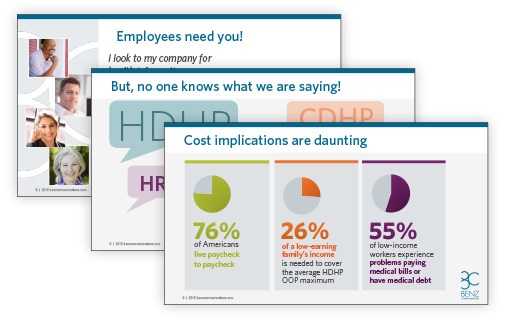
What the “H”? Eight FAQs About HDHP and HSA Employee Communications
Almost half of all employers are including high-deductible health plans (HDHPs) and health savings accounts (HSAs) in their lineup of employee benefits. Because these plans are more complicated than traditional health plans, well-intentioned companies are tailoring communications to help employees understand what HDHPs and HSAs bring to the table so they can make truly informed decisions.
Whether your company is introducing an HDHP and HSA to your benefits lineup this year or has had one in place for years, these tips will help you communicate about them effectively.
 Read on for answers to answers to eight of the topline questions asked during our Master Class Building Engagement: Making HDHPs and HSAs a Success. You can watch the webinar on-demand at any time.
Read on for answers to answers to eight of the topline questions asked during our Master Class Building Engagement: Making HDHPs and HSAs a Success. You can watch the webinar on-demand at any time.
1. What should my company call its new high-deductible health plan (HDHP)?
Let’s start with what not to call it, and that’s the high-deductible health plan or the catastrophic plan. Those are not appealing names. Instead, go with a simple name, like the Health Savings Plan or the Health Savers Plan—something that reinforces all that’s good about the plan, like its savings and simplicity.
2. What does it mean to pre-fund the Health Savings Account (HSA)?
If an employer is contributing to the HSA, you can pre-fund it so that all the money is available to employees on January 1. Doing this alleviates employees’ concerns about not having enough in their HSA to cover a medical issue that arises early in the year, and makes the plan more attractive. If you do pre-fund the HSA, you should promote it broadly in communications as a key feature of the plan.
3. Can the HDHP we offer be our default plan?
Absolutely. If you currently have a PPO and an HMO in place, it’s likely the PPO is your default plan. But when you introduce a consumer-driven plan, make it your default plan for new hires. If employees don't enroll, they'll automatically be enrolled in that plan. This strategy may be a bit more aggressive than you’re comfortable with, but it sends the right message to employees: This is the ideal plan. It offers the best value for our employees, and it ensures that everyone is covered. Also, keep in mind that your “default” communicates a lot. Behavioral economics has shown that people gravitate toward the default option, believing it to be the best choice.
4. My company has offered a full-replacement HDHP with a HSA for a number of years, but now we’re moving to a state that taxes the HSA funding on a state level. How can I communicate this change?
The message to emphasize here is: the federal tax savings from an HSA trumps any tax the state imposes. The financial impact to your employees won’t be significant. You will want to address the impact on their state taxes, but don’t under-emphasize the overall federal tax savings that they enjoy with the HSA.
5. If my company offers a PPO and an HDHP with HSA, can we still offer a healthcare Flexible Spending Account (FSA) for employees in the PPO?
You sure can. And you can also offer a limited-use FSA to employees who are in the HSA. Keep in mind the differences between HSAs, FSAs, and HRAs are confusing for employees. You’ll need to put extra effort into explaining those differences in your communications.
6. Do I need to use different strategies for communicating about an HDHP if I’m dealing with a union or an organization with collective bargaining units?
Any communication strategies that you’d use in a corporate environment would also apply in a union environment, with one caveat. As in any business, the organization’s culture—how much trust the employees have in their leaders—definitely plays a big role. Union members want things clearly and simply defined, which is where good communication comes in. However, in a union environment, it’s important to get the leaders on board first to be spokespeople for the plan. With their support, you can go out and talk to their members directly—which they often appreciate. You may even want to involve members in focus groups so you can get their feedback, make them feel like they’re part of the decision, and get them on board.
7. How effective are transparency tools as part of an HDHP?
Transparency tools—such as ClearCost, Castlight, and Change:Health care and those offered through your insurance plan like HealthSparq are fantastic. They’ve been the missing link in consumer-driven plans. But they’re also another resource that you—and your vendors—have to coordinate. When you're looking at how all of your vendors coordinate the tools you're going to provide, think about how the transparency tool fits in. Is it provided by an outside vendor, or is it something your health plan is offering? Then, be sure you promote it.
One of the misperceptions about benefits tools is that, “if we build it, they will come.” But this isn’t true for transparency and decision-support tools. If you want to offer a tool because you think your employees will benefit from it, you need to promote it, promote it, promote it! Make sure it’s integrated into everything else you do and that you put a lot of focus on marketing it.
8. Are “people like me” stories effective in promoting a high-deductible plan?
Yes, they are effective. But if you’re trying to drive people into a high-deductible plan and all the “people like me” stories end up with the high-deductible plan being the best choice, you should be transparent about that up front by saying something like, "For every scenario, the high-deductible plan is going to save you money. Here are five examples of how that works out." And then do the math for people.
But if it’s not true that in every scenario the high-deductible plan is the best choice, be honest about that, too. In other words, don’t make employees do a lot of work to figure it out themselves.
And if you’ve priced your plans so that the best choice is completely obvious—the high-deductible plan is so much cheaper in every scenario—it might be time to just rip off the Band-Aid. A lot of companies are hanging on to an old PPO plan just for the sake of having it there, but they're pricing it so outrageously that few employees will stay enrolled in it. Some employees are going to hang on to the PPO just because it’s familiar, no matter what it costs.
-1.png) Watch our Master Class!
Watch our Master Class!
Our Building Engagement: Making HDHPs and HSAs a success webinar will help you:
- Learn the formula for achieving solid enrollment in HDHPs (yes, there is one!).
- Gain key tips for helping employees choose plans, understand plan features and use HSAs effectively.
- Plot a strategy to sustain employee engagement throughout the year—not just at enrollment time.
Work with Us
We partner with organizations that value their people first. Let’s talk.

Jennifer Benz, SVP Communications Leader, has been on the leading edge of employee benefits for more than 20 years and is an influential voice in the employee benefits industry.
